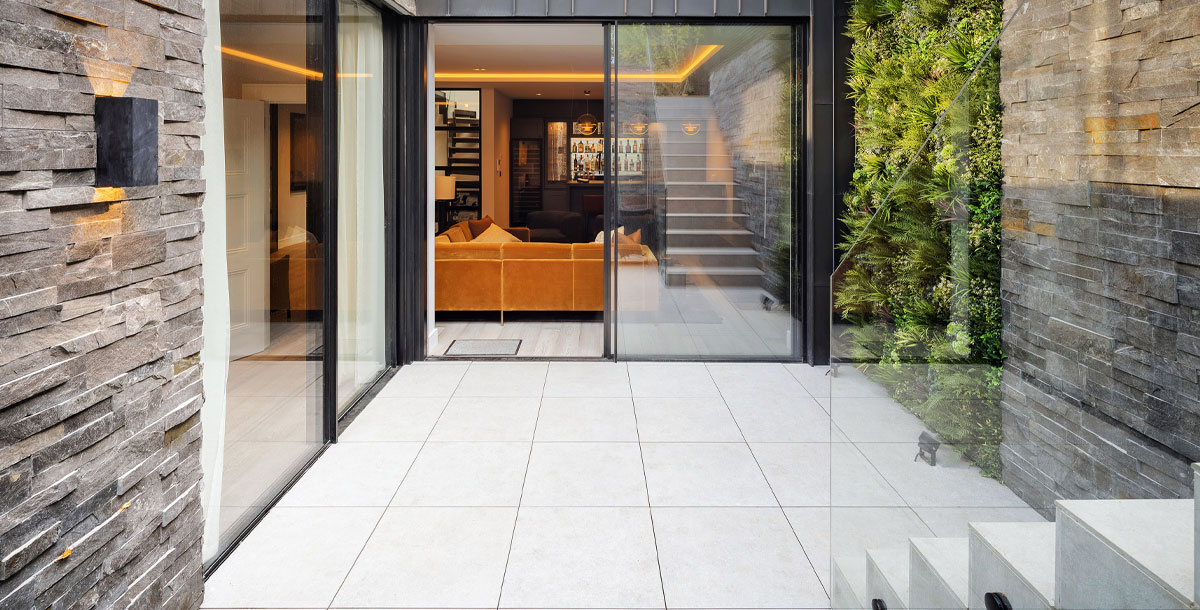How to choose outdoor flooring
Decking, paving slabs, bricks or tiles? How to select the best option for your garden
Take cues from the design of your house when choosing the material for outdoor flooring, whether patio or path. The orientation of the space and the sunlight it receives will also influence your options – white outdoor floor tiles may dazzle on a bright terrace and dark pavers look gloomy in a shaded spot.
The choice of wood and composite wood decking is vast, while porcelain tiles come in many formats and finishes, and stone slabs, brick pavers or gravel are options with a timeless appeal.
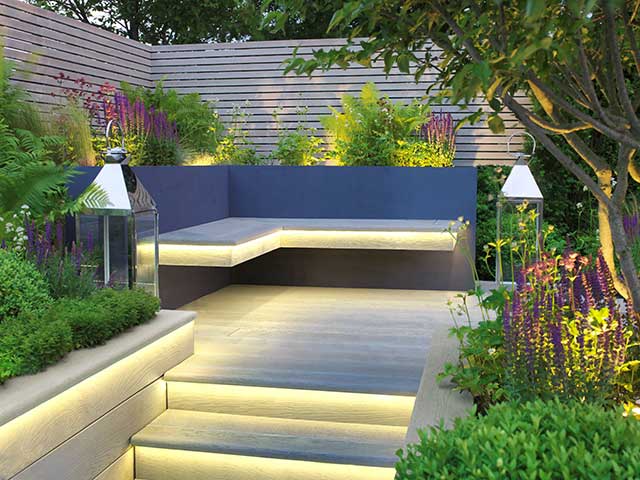
Made from a wood-free polyurethane resin core reinforced with mineral fibres, these composite decking boards have a rounded bullnose profile along one edge. Enhanced Grain Smoked Oak decking, Millboard
Before you buy
Preparing the ground, making a sub-base and the specific installation methods required vary with different types of outdoor flooring, so familiarise yourself with what’s involved as soon as you’ve identified which material you prefer. You’ll need to decide whether you can afford the time, disruption and cost.
‘Porcelain tiles should be laid onto a preprepared concrete base that has been left to cure for six weeks, secured with a suitable adhesive and an anti-mould grout,’ says Colin Lincoln-Evans, buyer at Tile Mountain.
Consider what to do about surface water drainage at the planning stage. It’s essential to create gradients that fall away from the house or any other building. It may be worth hiring a landscape gardener, who will understand the relevant factors. Try the Association of Professional Landscapers or the Society of Garden Designers. The Planning Portal has information on planning regulations relating to the use of water-permeable materials when paving or covering front gardens.
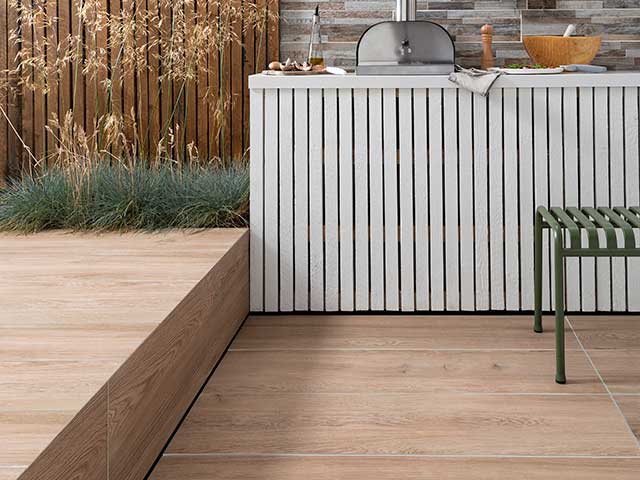
This wood-effect tile has a rich colour and is slip-rated R11. Oaktime Cherry outdoor porcelain tiles, 1,200x300x20mm, CTD Tiles
Choose decking for natural appeal
Relatively quick and easy to install, decking is a useful option for creating a level, raised platform on a sloping site. But a deck that’s more than 30cm above ground level will require planning permission.
Timber decking comes in hardwood, softwood or pressure-treated variants. Solid hardwoods such as ipe, balau and oak are durable, long-lasting and resistant to warping and rotting. ‘Balau and most hardwoods will silver over time unless they are protected to maintain their original colour,’ says garden designer Tom Howard.
Softwoods such as Scandinavian redwood, spruce and larch are resistant to moisture and rot, though more prone to denting. Premium-grade timber (Grade A) has fewer knots and offers the most longevity as outdoor flooring. Pressure-treated softwood is chemically treated under pressure to prevent decay. It costs around £24 per sqm and needs sealing every few years as, although it’s resistant to rot, it’s not waterproof and can warp and split if not protected.
Buy from a reputable supplier offering FSC-certified wood and look for a timber that has the DeckMark symbol from the Timber Decking Association as a guarantee of quality.
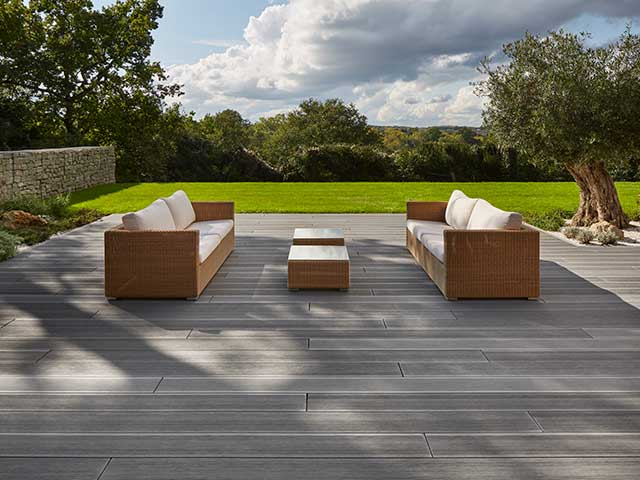
With a grooved surface that adds texture to a terrace, these deck boards are made from wood and resin. Trekker Vulcan Grey composite decking, 3,200x 143x22mm, Havwoods
Composite decking
Modified woods such as Accoya or Kebony are made from timber that has been processed to improve their durability, hardness and UV resistance. There’s less chance of them cracking or splintering, or damage from expansion and shrinking. They require very little maintenance as outdoor flooring and cost from £35 per sqm.
Composite decking is made from around 95% recycled materials, including reclaimed plastics and wood fibre. The engineered boards are low maintenance, don’t require staining or sealing, and won’t fade in sunlight. High-quality composites can look much like real wood, and cost upwards of £70 per sqm.
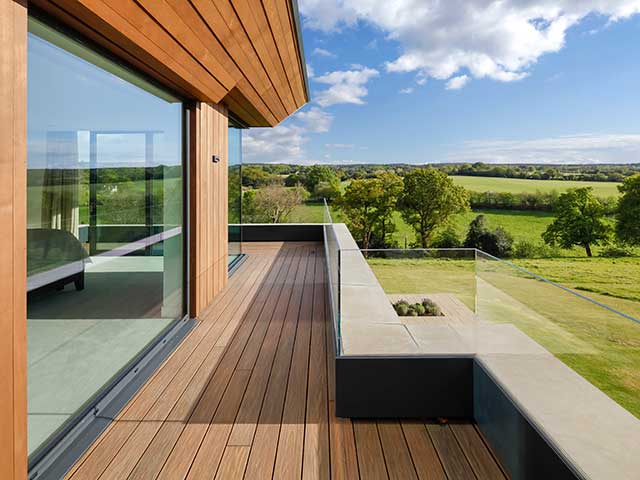
Replicating the look of solid wood, these engineered boards have a wood grain pattern and are made from FSC-certified timber and recycled plastic. HD Deck Dual in oak, Composite Prime
Outdoor floor tiles
Porcelain for outdoor flooring use comes in plains or patterns, or can replicate the look of stone or wood. Fired at a higher temperature than ceramics, 18-20mm thick exterior-grade pavers deliver a hardwearing, non-slip surface, even when wet. Look for a minimum slip resistance of R11+ or PTV36+ that will withstand heavy use and extreme weather. Big pavers laid inside and out are effective at creating a sense of connection from house to garden. Manufacturers offer coordinating ranges for this purpose, with the indoor tiles measuring 10mm thick and outdoor floor tiles 20mm thick.
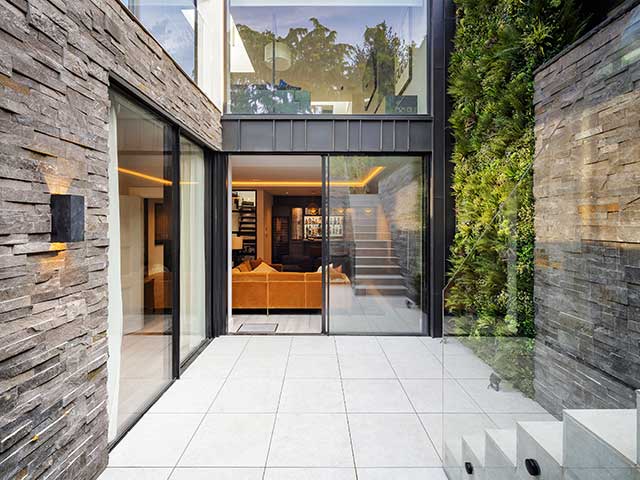
Fully vitrified porcelain is low maintenance, frost proof and UV resistant. Toledo Graphite porcelain floor tiles, 600x 600x20mm, Stone & Ceramic Warehouse
Stone slabs
Stone slabs suitable for patios and terraces, as well as paths and courtyards, include limestone, sandstone, granite and slate. Their surfaces can be textured, tumbled, riven or smooth. For a contemporary finish choose large-format paving, whereas a mix of randomly sized slabs gives a more traditional look. ‘Limestone’s markings and hardwearing characteristics provide a practical tile that will weather over time,’ says Isabel Fernandez, director at Quorn Stone. You can expect to pay from £49 per sqm for limestone.
Sandstone costs around £32 per sqm and comes in a wide range of colours, while slate is around £35 per sqm and granite £40 per sqm. As it’s porous, it’s advisable to seal all stone before and after grouting then seal regularly to prevent staining. Sealing this outdoor flooring also prevents excess moisture building up, reducing the risk of frost damage and algae forming.
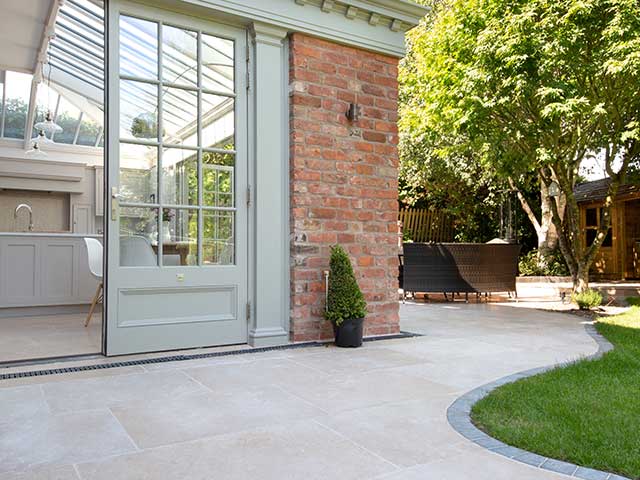
In beige and pale grey hues, this limestone comes in 20mm or 30mm thicknesses. Dijon tumbled limestone pavers, Quorn Stone
Brick and clay pavers
Brick pavers are made from clay and come in a range of colours, from earthy reds to contemporary charcoal. Straight-edge rectangular pavers give a contemporary finish, while tumbled and antiqued designs in reds and browns will complement historical homes. For a custom look, lay in a herringbone or basket weave pattern.
Clay pavers cost from £66 per sqm. They are frost proof and fade resistant, and any algae deposits that form over winter can be removed with water and a brush.
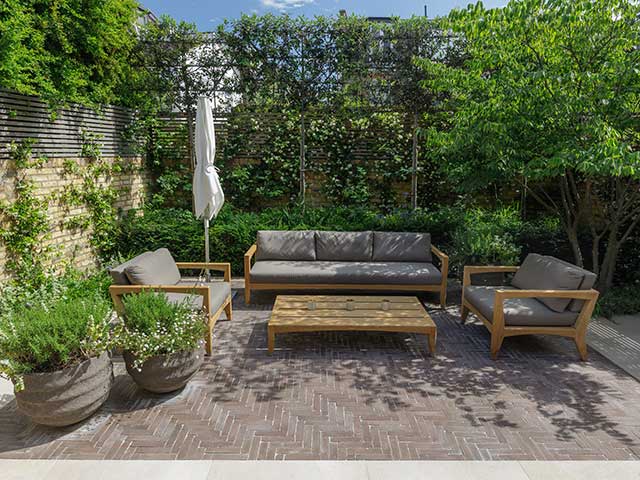
Laid in a herringbone pattern, handmade clay pavers from Vande Moortel’s SeptimA range takes centre stage in this courtyard garden designed by Henrietta Murray-Wicks and constructed by The Garden Builders

